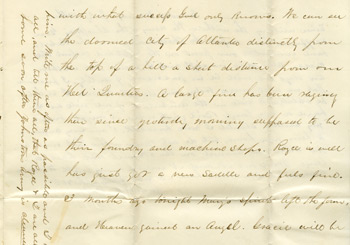Click Center Image for Full Size Picture
In early 1864, Union Major General William T. Sherman received orders to defeat the Confederate Army in Georgia. His adversary was General Joseph E. Johnston, who used delaying tactics, trading territory for time, to improve the defenses of Atlanta. As Sherman pursued Johnston, Johnston's soldiers would dig in, but Sherman steadily forced Johnston's outnumbered army to retreat from places like Resaca, New Hope Church, Pickett's Mill, and Dallas.
Sherman knew the looming Kennesaw Mountain would be a serious obstacle. The armies clashed there on June 27, 1864. Sherman was defeated, but Johnston had to withdraw several days later for the sake of his army. Sherman continued pushing, and the armies confronted each other several more times. John Cheney wrote to his sister-in-law Margaret Briggs on July 7 from the Chattahoochee River, "We can see the doomed city of Atlanta distinctly from the top of a hill a short distance from our Head Quarters."
Ten days after Cheney wrote that letter, Johnston was relieved of command and replaced by General John B. Hood.
July 7, 1864, Chattahoochee River, Georgia.
Hood attacked the Union at Peachtree Creek a few days later and was defeated. Battles at Atlanta, Ezra Church, and Jonesboro followed as the Union gradually moved closer to Atlanta. Cheney and his unit moved closer too, but Cheney himself would not participate in the taking of Atlanta. Union forces occupied Atlanta on September 2, 1864.










